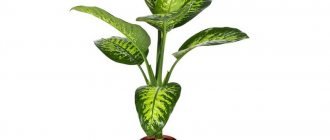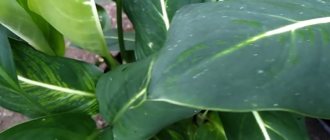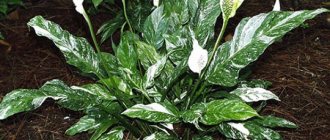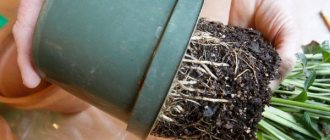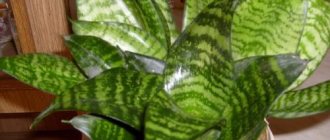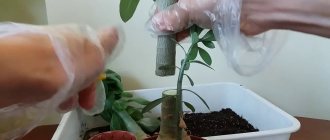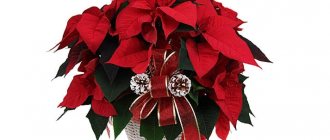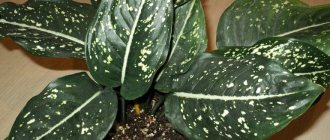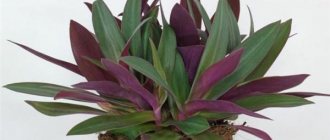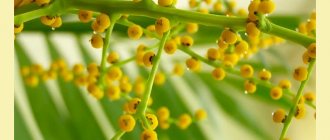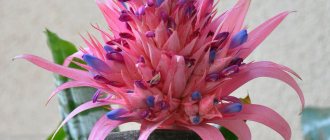Dieffenbachia is a popular houseplant with a straight trunk and large elongated leaves. Belongs to the aroid family. Some types of Dieffenbachia can grow up to 3 m. Such specimens are found in greenhouses, educational institutions, hotel lobbies, etc. In indoor conditions, they try to restrain the height of Dieffenbachia by periodically rejuvenating the plant or selecting a pot that limits the growth of the root system. You can also purchase Dieffenbachia, the variety of which is initially programmed for compact, small growth. These also happen.
In general, Dieffenbachia at home shows itself as an undemanding plant. We can recommend it for beginners.
Location and lighting
Dieffenbachia requires a large amount of light, only then will the unusual color of the leaves be preserved.
The light should be diffused, since under the influence of direct sunlight, burns may appear on the surfaces of the leaf plates. A window sill located next to a window with east or west orientation is suitable for placement. The south side is not recommended as a placement location, however, you can also place a pot of Dieffenbachia here, protecting it from direct sunlight. For shading, use small curtains, blinds or special films that adhere to the glass. Dieffenbachia does not do well near a north-facing window because it does not have enough light. If it is not possible to place the plant in another place, arrange additional lighting by installing a special phytolamp or making a backlight using ordinary fluorescent lamps.
Lack of sunlight negatively affects the condition of the leaves: they become smaller and lose their variegated color. You should not constantly move the flower from one room to another. Dieffenbachia does not tolerate drafts: due to exposure to cold air, the leaves begin to turn yellow and fall off. During ventilation, the flower must be removed away from the source of the draft, and best of all, taken out of the room. The plant loves fresh air, so in the summer Dieffenbachia is placed on the veranda or balcony, protected from direct sunlight and wind.
Varieties of Dieffenbachia
On the Internet you can find photos of many different types of this flower. Here are the most popular ones.
Spotted Dieffenbachia
The most common type. It often serves as the basis for developing new varieties with unusually spectacular patterns on the leaves. The surface of the leaf blades of some varieties of Dieffenbachia spotted may be different. Another name for this species is Dieffenbachia painted.
Camilla
This species has a bush form. Light lemon, almost white leaves have a bright light green border along the edges.
Lovely or Seguina
A plant with rounded, oblong leaf blades, in the center of which there is a light herringbone pattern. The edges of the leaves are dark green. In good lighting, this contrast becomes more pronounced.
The contrast of the dark green edges and background makes the plant very noticeable and attractive. In good lighting, the pattern is brighter and more noticeable.
Compacta
Compact variety. In terms of decorativeness, it is in no way inferior to its tall brothers. Such a bush can be placed even in a small apartment.
Oersted
The elongated leaves of Dieffenbachia of this variety are decorated with a contrasting light stripe located along the central vein.
Reflector
The color of the leaves of this species is unusually bright and contrasting. Light yellow or bright light green spots appear to be splashed across the entire surface of dark green leaves.
This species is less susceptible to ultraviolet radiation, but is more demanding of indoor humidity and regular watering, and is very sensitive to temperature changes.
Dieffenbachia is a wonderful decoration for a winter garden, office, private home or city apartment. Thanks to their intensive growth and ease of propagation, you can quickly create a cozy corner filled with lush, colorful greenery. Plants respond gratefully to caring treatment.
You should never forget that Dieffenbachia juice is toxic. When caring for a plant, it is important to follow simple precautions.
In this case, breeding Dieffenbachia will bring a lot of positive emotions, and, perhaps, lead to new discoveries.
Diseases and pests of Dieffenbachia
It should be noted that diseases and pests can colonize the flower if Dieffenbachia care does not meet the requirements. A strong plant itself resists diseases. Of course, you can populate insects from a neighboring flower or use soil with living fungal mycelium for replanting, but this only means that the care of the plants on the windowsill is poor.
Signs of fungal diseases are the appearance of uncharacteristic spots, stripes, and weeping and drying leaf edges on the leaves.
When the root system rots, it cannot provide the plant with nutrition, and yellowness appears on the leaves.
This makes itself felt by diseases such as:
Anthracosis attacks the upper part of the plant. The appearance of dry spots that enlarge and destroy the leaf is the most characteristic manifestation of the disease. Spores can get in with irrigation water. The disease is caused by dry indoor conditions and excessive watering. You can treat with fungicides and remove the infected parts of the plant. Normalize the regime of detention.
Fusarium spreads to the roots and the entire plant. The mushroom lives in the soil. Therefore, it is important to sterilize the substrate when replanting a plant. You can save the plant at the earliest stage of the disease by treating it with a fungicide, cutting out the affected areas and taking new dishes and soil.
The viral disease manifests itself as curled leaves and a bronze tint on the top of the plant. Carried by insects from diseased plants. The diseased plant must be destroyed. You cannot take material from him for reproduction.
Insect pests that have colonized the flower feed on the juices and spoil the appearance of the flower. If the colony becomes large, it can kill the plant. Several types of pests reproduce on the poisonous Dieffenbachia:
Measures to combat them are known - first, soapy water, later - insecticides.
Problems you may encounter when growing Dieffenbachia
If basic care rules are not followed, you may encounter some difficulties.
The main most common problems include yellowing of leaves, lethargy, drying out and lack of plant growth. In order to solve them, it is worth establishing the cause.
Yellowing leaves can be caused by exposure to direct sunlight, while leaf lethargy is a result of rot and poor drainage. To solve the first problem, it is enough to move the pot to a less lit room, and when curling the leaves, you need to remove the flower, inspect the roots and change the soil. Drying of leaf blades is often caused by drought, so it is worth spraying Dieffenbachia leaves more often. Lack of plant growth hints at cold or inappropriate lighting.
In addition, the plant may be susceptible to parasites or diseases. The main pests that attack Dieffenbachia are mealybugs, scale insects and spider mites. When they appear, it is necessary to treat the flower with insecticides, which are available at any flower shop.
Professional help from gardeners and gardeners Still have questions? Ask, don't hesitateAsk a question
The most common disease is rotting. It can be caused by improper or excessive watering. The plant will begin to wither and the leaves will dry out. If such signs appear, it is recommended to remove the plant from the pot and inspect its root system. If there are damaged parts, it is necessary to resort to their removal.
Caring for You: Simple Tips
Dieffenbachia at home can not only grow, but also bloom, bear fruit and reproduce in various ways.
How to water Dieffenbachia? The main thing is not to over-moisten the soil. Dieffenbachia should be grown in flowerpots with good drainage and in soil of a special composition containing 1 part sand, two parts peat, two parts turf soil and 1 part humus. Carefully check the turf for the presence of insect larvae and worms, so that later you don’t have to look for the reason why the leaves are drying or whether the plant has a mysterious disease. For drainage, it is better to use expanded clay or broken brick.
One of the secrets of how to care for Dieffenbachia is the correct placement of the plant relative to the light source. When growing different varieties, we try to orient rich green plants closer to the window, variegated ones and with large white splashes - to shade them or place them in the far corner. Variegated varieties grown in bright light can easily lose their decorative properties.
Periodically, the leaves on the plants need to be wiped. It is recommended to use a damp cloth, and since the plant is poisonous, this procedure is best carried out with gloves. Dieffenbachia can be easily washed at home using a terry sock placed on your hand. We settle the water in a bucket (ideally, we take boiled or even distilled water, so as not to leave white stains on the leaf), rinse our hands in the bucket and evenly wipe the entire area of the leaf, without fear of getting the plant juice on the skin.
By the way, the benefits and harms of Dieffenbachia are the subject of debate among amateur florists: is it possible to keep a planted flower with a dubious reputation at home?
All tropical plants are poisonous to a greater or lesser extent. If Dieffenbachia juice fails to get on the skin, irritation in the form of redness may develop, and contact with the eyes can cause temporary blindness. Of course, Dieffenbachia should be kept away from small children. But it brings much more benefits than expected. It turns out that Dieffenbachia at home has a unique ability to purify the air from benzene and fromaldehyde, turning the atmosphere of a city apartment into the cleanest air of the Amazon.
With reasonable care, we can enjoy this majestic plant that turns our home into a green kingdom.
Harm of Dieffenbachia: myth or reality?
Dieffenbachia is a very spectacular plant, but many gardeners refuse to plant it at home. This is because there is a widespread belief that Dieffenbachia is supposedly extremely toxic. But it's not that scary. Dieffenbachia juice actually causes irritation to the skin and mucous membranes. How does this manifest itself? Skin exposed to Dieffenbachia juice (for example, when dividing cuttings) will turn red and itch. It is enough to wash off this juice with plain water and everything will pass. Perhaps allergy sufferers will have a worse time and the redness will be more significant. That's all! Nothing fatal. Are you afraid of itching? Wear gloves when handling Dieffenbachia; its juice does not corrode rubber.
Parents of small children or animal owners think more seriously about whether it is possible to keep Dieffenbachia at home. What to say? Many cats happily gnaw the lower leaves of Dieffenbachia. And they live happily ever after. Although, of course, it’s better not to take risks and, if you notice a chewed leaf, monitor your pet’s well-being. And if anything happens, take it to the vet! Although, with a greater degree of probability, Dieffenbachia will not cause any harm to the animal. Rather, on the contrary, the plant risks losing its decorative properties due to the taste preferences of your cat.
As for children, it is, of course, not worth conducting experiments. Place the Dieffenbachia out of reach of a small child. When he grows up, explain that this plant is poisonous and you cannot tear its leaves, much less put them in your mouth. There may be a burn to the mucous membrane, which is especially dangerous for allergy sufferers.
Thus, the harm of Dieffenbachia is a relative value. But the benefits are obvious. This large size has amazing properties to absorb various air pollutants, such as toluene, xylene, formaldehyde, benzene ( Ficus Benjamin ). This means that the air in the room where Dieffenbachia grows will be free of these chemicals. But that is not all. Dieffenbachia, which has large leaves, is capable of releasing large amounts of oxygen and ionizing the air. And lastly, again, the large leaves of Dieffenbachia evaporate a large amount of water from their surface, and accordingly, increase the air humidity in the room.
Rules for caring for Dieffenbachia at home
The tropical guest tolerates and forgives many mistakes of beginners. Dying specimens quickly take root and easily succumb to “reanimation” conditions. But you shouldn’t test the strength of such a beautiful culture. Full care for it consists of creating a moist environment, timely feeding and pruning the stems.
How to properly water and spray Dieffenbachia
Caring for Dieffenbachia flowers at home requires special attention to water procedures. The plant reacts painfully to lime, so the water for watering and spraying must be well settled. You can filter or boil it, or use rainwater.
Abundant watering in summer and moderate in winter is required. The culture does not tolerate excess moisture. In order not to provoke rotting of the rhizomes and stems, make sure that the soil in the pot does not resemble liquid mud and does not dry out. It is advisable to alternate watering (from the top and through the pan). At low temperatures, it is better to replace spraying by washing the leaves.
When and how to feed Dieffenbachia
The flower grows quickly, using the entire reserve of substances necessary for its formation.
Fertilize it in the spring-summer period up to three times a month. Fertilizers are applied to choose from: liquid mineral or organic
.
By the way, some types of Dieffenbachia with white leaves lose this varietal feature, turning into rich green ones, due to the nitrogen content in complex fertilizers.
Features of plant transplantation
The optimal period for transplanting Dieffenbachia at home is February - May. The procedure should be carried out as the root system grows, sometimes even a couple of times a year.
To do this, choose a container with a diameter several centimeters larger than the previous one. An impressive layer of coal is placed on the bottom for fertilizer and drainage, the earthen tuber with the plant is carefully transferred, damaged roots and adhering drainage residues are removed. Sprinkle fresh slightly acidic soil on top and water.
How to prune Dieffenbachia
When you already know how to water and what to feed Dieffenbachia at home, you need to find out the rules for regular pruning of the plant. Under favorable conditions, the plant produces a new leaf every week, exposing the lower part of the stem. As a result, the indoor beauty loses its decorative effect.
Important! To select a sprout for planting, any part of the Dieffenbachia stem is suitable. It can be carried out at any time of the year, remembering that:. the plant is poisonous (to avoid contact of toxic juice with the skin, all work must be carried out with gloves); pruning is carried out only with a sharp knife, which is pre-treated with alcohol; when working with Dieffenbachia, you need to protect your eyes so that poison does not splash; the juice that appears is removed by wiping it with a soft cloth, and for disinfection, the sections are treated with crushed charcoal; After work, hands should be washed with soap.
the plant is poisonous (to avoid contact of toxic juice with the skin, all work must be carried out with gloves); pruning is carried out only with a sharp knife, which is pre-treated with alcohol; when working with Dieffenbachia, you need to protect your eyes so that poison does not splash; the juice that appears is removed by wiping it with a soft cloth, and for disinfection, the sections are treated with crushed charcoal; After work, hands should be washed with soap.
Important! In stem species of Dieffenbachia, the stem is radically cut off once every 3-4 years, leaving a stump of no more than 10 cm. And in bush species, only damaged and dried leaves are removed.
Trimming
An important step in growing a plant is pruning. You can form a flower at any time of the year, the main thing is not to harm the plant. Basic rules for pruning Dieffenbachia:
- All parts of the plant are poisonous, and the trunk is no exception. The place where the flower is cut should be blotted with a rag and the resulting juice should be removed.
- Gloves must be used during work, after which hands are washed thoroughly.
- To prevent the development of Dieffenbachia diseases, the stems should be cut with a sharp knife or scissors disinfected with alcohol, and the cut site should be treated with crushed charcoal.
Flower pruning
Where is the best place to place Dieffenbachia?
Due to its ability to purify the air from formaldehyde, trichloroethane, xylene and benzene, the flower is recommended to be placed in areas with unfavorable ecology - that is, areas heavily polluted by industrial and automobile exhausts. At home, there is no better place than the kitchen for a flowerpot, especially if its windows overlook a busy road.
If you follow the rules of Feng Shui, a corner near a desk is perfect. This evergreen inhabitant of the tropics humidifies the air well, neutralizes microbes, and has a beneficial effect on the nerves. But in addition to its positive qualities, superstitions say that the plant takes away male power. That's why he's feared in bedrooms.
What kind of lighting does Dieffenbachia need?
When wondering how to grow Dieffenbachia, you should not forget about the peculiarities of the climate of its homeland. A lot of heat, light and moisture is all that a flower needs for full growth in indoor conditions. Moreover, the more spots on the leaves, the more light you give them.
Did you know? The indoor Dieffenbachia from the genus Araceae received its name from an Austrian botanist in honor of the senior gardener of the Vienna Botanical Garden, Joseph Dieffenbach.
It is important to avoid direct exposure to sunlight, which takes away the plant’s brightness and wilts it. At the same time, the light must be diffused
The ideal distance would be a meter or two from the window on the sunny side. If you have the opportunity to additionally organize artificial lighting, the pot can be moved further away.
Temperature regime for the plant
This is the next whim of the fastidious Tropican. It does not tolerate drafts, reacting to them with intense loss of foliage and wilting. In summer, the room where Dieffenbachia grows should be between 20 and 30 °C, and in winter not lower than 15 °C, otherwise do not be surprised by the sudden yellowing of the leaves.
Also avoid sudden changes in temperature. especially if you are going to transport your green pet somewhere. In winter, do not place heating devices nearby. Dieffenbachia loves fresh and moist air.
What should the air humidity be for successful growth?
Knowing what Dieffenbachia loves, it is important to ensure that the humidity in the room does not fall below 65%. Of course, in winter it is difficult to maintain such a standard in an apartment with central heating.
To do this, experienced florists recommend spraying and washing the leaves with warm water, the more often the better. Small flowerpots can occasionally be given a shower (not cold) by covering the soil in the pot.
Is it really still blooming?
Dieffenbachia is considered a deciduous plant, but nothing beautiful is alien to it. If the right care conditions are met, it is quite capable of blooming. The Dieffenbachia flower is typical of all representatives of the araceae. It is a long cob surrounded by a greenish or creamy blanket.
Although, blooming Dieffenbachia in indoor conditions is rare. Most gardeners who successfully grow Dieffenbachias as foliage plants have never seen them bloom. All that remains is to admire the photo of Dieffenbachia in bloom.
Dieffenbachia blooming is an unusual sight!
Caring for Dieffenbachia at home: watering and lighting
The location for placing Dieffenbachia is chosen to provide bright lighting without direct sun. In winter, it can grow well in partial shade, away from the window, subject to additional lighting. It is good to place a flower near a window covered with a tulle curtain.
A distinctive feature of the culture is its heat-loving nature; the growing temperature of Dieffenbachia should not be lower than 18 °C; in summer it is 18-24 °C, with a maximum of up to 30 °C. In winter, the plant can briefly tolerate a decrease to 10-12 ° C, but this will certainly affect its appearance, causing yellowing of the lower leaves. Optimal for the winter period is 17 °C, with minimal differences between day and night. You should not place the flower near heating appliances. Dieffenbachia loves fresh air; in the summer it can be located on an open balcony or loggia, if it is possible to provide it with shade and no drafts. The crop does not tolerate the latter and immediately reacts to them by yellowing and falling leaves, so it is better to take the flower out of the room even while airing.
When watering Dieffenbachia, certain rules must also be followed. This tropical crop is moisture-loving, but does not tolerate waterlogging, which causes root rot, especially at low temperatures. The earthen ball should be moderately moist, but not wet; watering is done with warm, settled water only after the top layer of soil has dried.
Decorative Dieffenbachia in the photo
Like any fast-growing flower, the crop needs regular feeding; during the period of active growth from May to August, they are carried out every 10-14 days, in winter and autumn - once a month or less. A weak solution of complex flower fertilizer is used as a fertilizer for Dieffenbachia; fertilizing with nitrogen-containing organic matter is also useful. With a lack of nutrients, the plant sheds its lower leaves and exposes the trunk, and also loses its brightness of color.
To successfully grow Dieffenbachia, home care must necessarily include measures to increase environmental humidity. Due to the large surface of the leaf plates, the flower suffers greatly from dry air. The optimal humidity at which the plant feels good is at least 60-70%. Obviously, it is impossible to create such a microclimate in an apartment with central heating, so daily spraying is used to increase humidity; it is also useful to wipe the leaves with a damp cloth or sponge once every 2 weeks. For these procedures, warm boiled water is used; hard tap water causes plaque to appear on the sheets and they lose their decorative properties.
When spraying, you must pay attention to the absence of drafts and air temperature, otherwise, instead of benefit, you can cause harm to the delicate flower. Even at +18 °C, it is better to replace spraying with wiping
The culture develops and grows all year round, requiring constant temperature in summer and winter, however, according to experts in growing indoor Dieffenbachia flowers, caring for them in winter should provide the plants with a period of rest. At this time, watering and fertilizing are limited, which makes it possible to avoid the appearance of small leaves due to insufficient lighting.
It should be noted that for stem and bush Dieffenbachia, the care is almost the same, differing mainly only in the volume and regularity of pruning, which will be discussed in detail below.
Signs and superstitions
Dieffenbachia can be called one of the most magical plants; many signs are associated with it. In ancient times, the flower was used to torture slaves, so it is believed that such a plant cannot bring anything good. Dieffenbachia was not planted in their homes not only because of its toxicity, but also because the flower promised misfortune and death to all residents.
Important! If there are children or pets in the house, it is not recommended to keep such a plant.
Getting a healthy Dieffenbachia flower is not that difficult. The main thing in growing it is to pay attention to humidity and feeding in the warm season.
Dieffenbachia: care at home
When caring at home, Dieffenbachia requires compliance with temperature and light conditions, watering, fertilizing and protection from pests.
Temperature
Comfortable conditions for a flower in summer are 22-25 degrees, in winter – 16-18 degrees. He is afraid of drafts, in the summer he needs to be put on the balcony - because of his love for clean air. Keeping a flower in direct sunlight is dangerous - its foliage will burn and unsightly defects will appear on the plates.
Lighting
The Dieffenbachia plant needs bright light - only with it it grows quickly and produces beautiful spotted leaf plates. Direct exposure to sunlight can cause burns and further illness.
Important! If there is no sunny room, there is no need to worry - the plant is a shade-tolerant species.
Watering
The shrub requires regular moistening; dust must be wiped off the foliage weekly using a damp cloth.
Leaves need to be wiped regularly
Spraying
In spring and summer, the plant is periodically sprayed and given a shower. In order not to provoke excessive moisture, the lower part is covered with plastic wrap before the procedures.
Humidity
The houseplant grows well in high humidity levels. Due to this feature, it is necessary to constantly care for it: regularly spray it, and place an aquarium next to the box.
Important! In winter, humidification is increased due to drying of the air by heating devices.
Priming
Flower shops offer a special mixture designed for Dieffenbachias. If desired, you can make a nutritious soil mixture with your own hands: take 1 part sand, humus and 3 parts earth.
Feeding
Caring for Dieffenbachia involves adding nutrients. Regardless of the variety, the shrub is characterized by rapid growth, which requires a lot of effort. Restorative feeding in the summer months is carried out every 7-10 days. The plant prefers a nitrogen-organic mixture and special additives intended for variegated species.
Features of Dieffenbachia. Popular varieties
Today, about thirty species of Dieffenbachia are cultivated. Why is this indoor flower so fascinating to plant growers? Firstly, the “light” has a very powerful trunk, almost like some types of trees. Secondly, on the surprisingly powerful trunk there is a whole armful of dazzlingly variegated, incredibly large leaves. Thirdly, the plant is not dwarf, and some varieties can reach up to two meters in height. Every lover of unusual flowers wants to have such a “chic beauty” in their collection! Despite its whimsical nature, Dieffenbachia has long and firmly taken its place in the ranking of the most beloved indoor plants among gardeners in our country.
To give specific examples, you can often find Dieffenbachia Seguin , characterized by wide and very long leaf blades (each can reach up to half a meter in length). Quite often, plant growers breed Oersted Dieffenbachia , which is characterized by amazing elongated heart-shaped leaves with a clearly defined bright central vein.
Not a single gardener who is keen on the “sparkle” will pass by the spotted dieffenbachia . It, like D. Seguina, is distinguished by long, pointed leaf blades up to half a meter in length. If the grower manages to get Dieffenbachia Seguin to bloom (which, unfortunately, happens very, very rarely at home), then he will be able to admire the amazing crimson-colored berries.
Despite its popularity, Dieffenbachia is a fastidious plant. To prevent this “light” from going out in the flames of your home, you will need very little effort and accuracy, a little patience and attention to your “green pet”. Dieffenbachia cannot be classified as a plant with a “classical” type of care, so watering and periodic fertilizing alone are not enough.
We will offer you a basic list of recommendations, following which you can grow not only a beautiful, but also a healthy plant. And it will become a delightful decoration for your home greenhouse!
Botanical characteristics
Growing an indoor evergreen herbaceous plant is not too difficult. The plant has thick and straight, fairly fleshy stems and large, oblong, glossy or matte alternate leaves. Varieties with green or variegated foliage are well known. Variegated species have an attractive appearance, and the leaves are covered with a pattern represented by light green or yellow specks, stripes and spots. It is thanks to its high decorative value that the plant is in great demand in indoor culture.
Particularly popular are Dieffenbachia spotted and Dieffenbachia variegated, which became the progenitors of a large number of hybrid forms that differ in size and color of leaf plates. The indoor flower is characterized by rapid growth rates. Proper cultivation and creation of comfortable conditions allows the plant to form one new leaf every week. The upper part of the shoot has a growth point, but at home the height of an adult indoor flower varies between 0.5-2 m. Some varietal varieties have dormant buds, the awakening of which causes the plant to tiller.
Over time, the foliage on the stem part turns yellow, dries out and falls off, which causes the trunk part to become exposed, and the plant becomes like a palm tree with succulent, variegated leaves at the apical part. If the plant loses its decorative qualities, it needs to be re-rooted. Some types require mandatory updating every three years.
Dieffenbachia blooms in mid-summer, but in the conditions of indoor floriculture, the ornamental crop acquires flowers extremely rarely. Along with other representatives of the Aronia family, Dieffenbachia flowers are small in size, yellowish-white in color, and completely inconspicuous. Then small and bright, orange-red berries ripen on the plant. This process provokes inhibition of growth and shedding of the lower foliage, so experienced amateur gardeners remove the buds completely.
Benefits and harms
The main beneficial property of Dieffenbachia is that it perfectly purifies toxic air. The plant removes xylene and formaldehyde.
Also good for purifying the air: Anthurium, Ficus Benjamin Kinki, Peperomia obtufolia, Hoya Carnosa, Decorative-deciduous Begonia, Dracaena Fragrance (Fragrans) and some others.
The plant can be harmful, but only if you touch its juice with your bare hands. It is especially toxic to mucous membranes and open wounds.
The scientific name of the plant is Dieffenbachia. The international name is no different, only the word “Schott” is added.
Transplantation and propagation of Dieffenbachia
Young plants can be replanted once a year
It is important to select the next container correctly. It is recommended to take a pot a couple of centimeters larger than the previous pot
Adult specimens should be disturbed much less frequently and replanted only every 4 years.
Dieffenbachia transplant
Replanting a plant requires care and caution. It is best to act according to a certain algorithm so as not to harm Dieffenbachia
- Take a new pot for Dieffenbachia and place a drainage layer on the bottom.
- Place a small amount of soil on top.
- Remove the plant from the pot and carefully examine its roots. If defects are found on the roots, it is best to cut them off. The cut areas will need to be treated with activated carbon.
- Without shaking off the soil, you need to move the Dieffenbachia to a new pot.
- Fill the sides with soil and water the flower.
When the plant has reached a large size, you should not send it to a new, deeper container. It will be enough to update the top layer of soil.
In order to learn how to propagate Dieffenbachia at home, you need to study 4 different methods:
Seeds. This method is used by specialist breeders to develop new varieties. Seeds are obtained by hand pollinating male and female flowers.
Top cuttings. When the plant is stretched upward and the stem has no leaves, the top is cut off. It is placed in water or a peat-sand mixture. During the growth process, it is recommended to spray the cuttings and protect them from direct rays.
Stem pieces. The pieces are cut into several cuttings up to 20 cm in length. They are dried for 2 days and then placed in a substrate of sand and peat. After this, the container is covered with film and remains at a temperature of +25 degrees for 6 months.
Propagation of Dieffenbachia by stem pieces
Layerings. A cut is made on the stem and wrapped with film. All this is fixed with tape or thread, and after that you can observe the appearance of roots, which are cut off and planted in a separate pot.
Bloom
Dieffenbachia with inflorescence
Dieffenbachia at home rarely blooms. It is valued not for its flowers, but for its beautiful leaves. The flower develops in spring in April-May. It develops in about 2 weeks and blooms for 3 days. It has the shape of a cob.
Flower growers advise removing emerging flowers. They are not beautiful, and they take a lot of energy from the plant. It smells like plastic with a sweetish note. If you leave it, it is better to take it out of the living space.
If you want to see your Dieffenbachia bloom, you need to create a stressful environment for it. To do this, place it in a well-lit place, but deprive it of fertilizer and watering. You need to torture the plant until the leaves droop. Then he needs to be revived. Place in a container of water until the leaves come to their senses and a bud appears. After this procedure it should start.
Plant care
Caring for Dieffenbachia at home includes basic agrotechnical measures: watering, pruning, fertilizing and replanting.
Watering and fertilizing
You need to start with water quality. Boiled or settled water should be used not only for watering, but also for spraying and wiping the flower. Hard water can cause leaf tips to drill and fall off. Oxalic acid will help soften the water. You can use non-cold rainwater. If you want to wash the plant in the shower, the water should be slightly warm and not get into the soil. Dieffenbachia needs to be watered regularly, and in summer also abundantly. The soil should not dry out, but a swamp is not welcome either. Winter watering should be more modest; the quality of the soil can be taken as a guide. In summer, the flowerpot is watered several times a week; in winter, as a rule, once is enough. Since the flower does not have a clearly defined dormant period, it can be fed all year round, taking into account the fact that in spring and summer, fertilizing needs to be done more often and it should be more varied.
During the active phase of the growing season, the plant is fertilized twice a month, in winter - once every month and a half. Of course, special complex fertilizers are best, but you can use others, the main thing is that they do not contain lime. The best option would be a liquid fertilizer with mineral and organic nitrogen-containing elements. Nitrogen is not suitable only for white leaf varieties.
Trimming and shaping
Dieffenbachia, like any other actively growing plant, needs formative pruning, otherwise soon instead of a neat bush flowerpot (size does not matter), you will end up with a neglected riot of leaves.
Even the smallest and neatest bush needs to be updated. And there’s no need to remind you that you need to cut off a dried or damaged leaf. Before you start pruning or just want to shorten a little, take care of safety
Trimming Dieffenbachia is not difficult, but it is important to know how to do it correctly and safely. Damaged sheets must first be blotted to prevent toxic juice from getting into the eyes or skin (it is recommended to use medical gloves for work)
The pruning knife must be sharp and disinfected. Then the leaf is cut off completely, if necessary with part of the trunk. The sections are also blotted and sprinkled with crushed coal.
The plant is replanted almost annually, the need depends on the growth rate. The signal for the need for the procedure is that the pot becomes too tight for the roots. The bush is replanted at the end of winter or early spring; a plant transplanted in summer may not take root. Since the roots of the flower are fragile and brittle, it is better to replant using the transshipment method, together with a lump of earth. In a new container, slightly larger (slightly), you need to place a new drainage.
Only old bare plants need pruning. You can buy the substrate ready-made or prepare it yourself. To do this, you will need leaf soil, peat, humus, sand and birch charcoal, which will cleanse the soil of excess salt. At first, a growth stimulator is added to watering.
Reproduction
There are several ways to propagate the plant: apical cuttings, stem and air layering. Propagation by cuttings is the most popular method. To do this, the cut bare parts are blotted and placed in any nutrient medium (water, moss, peat). The temperature should be moderate, about +22 °C, and the plant should not be exposed to direct sunlight. You also need to take care of spraying. When the roots have grown a few centimeters, they can be planted.
Is it safe to grow Dieffenbachia at home?
Dieffenbachia is a poisonous plant. A wild plant needs protection from pests, and the poisonous sap meets this need.
At home, it will not cause harm if you handle it correctly
The potty should be kept out of the reach of children and animals. So that they don’t accidentally try its leaves, which attract with their brightness.
Even a small piece of Dieffenbachia can cause a burn to the oral mucosa and respiratory tract. If it enters the stomach, there is a risk of internal bleeding.
It is better to avoid the plant when there is a cat at home. It is very difficult to remove anything from them. Since they can climb into any hard-to-reach place. Its juice, if it gets into the pet’s esophagus and stomach, can be fatal.
The plant is dangerous for allergy sufferers. In case of individual intolerance, it can cause heart failure
There is a popular belief about Dieffenbachia that it scares men away from home. People call it the “widow’s flower.” Allegedly, her owner, even if she starts a family, will not be able to give birth.
Another interesting fact about the plant. In Africa it was nicknamed “the silent rod.” In slave societies, its leaves were forced to be chewed by slaves as punishment. The milky juice affected the larynx and oral cavity. The man couldn't talk. This was the punishment for arguing with the owner.
Despite beliefs and poisonous properties, it is common in homes. She is grown and nurtured
The main thing is to take all precautions in this process.
Pomegranate at home: growing from seed and care, beneficial properties and contraindications (Photo & Video) + Reviews
Possible problems in cultivation and diseases
Violation of the requirements for caring for ornamental trees often leads to the development of diseases. Sometimes the problem is due to pest attacks. It is immediately clear what a diseased Dieffenbachia looks like: all manifestations are reflected on the foliage.
The leaves of a diseased flower are usually damaged
Drops buds and leaves
If the bush is actively getting rid of foliage, then the phenomenon is associated with rot. It is caused by excessive humidity. You can check the assumption by the state of the soil mixture: even with rare or absent moisture, it does not dry out completely. Treatment consists of step-by-step cutting of the affected root system and sprinkling the cut areas with activated carbon.
The leaves are turning pale
The fading of usually bright and colorful foliage is associated with exposure to direct sunlight. The flower must be moved to partial shade, all damaged leaf blades must be cut off - they will not be restored.
The tips of the leaves are drying out
Drying of the tips of the plates is the first alarm bell, which may be followed by massive drying out of the foliage. If the feature appears in an adult plant, then the causes include natural aging processes. In cases where the entire flower has begun to dry out, the source of the problem may be:
- insufficient spraying and moistening;
- increased air dryness;
- hot weather.
Important! Ignoring the problem of artificial drought often ends in the death of the flower
The lower leaves fall off
Rapid growth causes yellowing and loss of foliage at lower levels.
Attention! If the leaf drop affects the entire plant, then it is trying to report drafts or too low a room temperature
Pests
The main problem of the bush is attacks by spider mites, mealybugs, scale insects and aphids. What is the main sign of an attack: the leaves begin to turn yellow and become covered with foreign matter. A small number of pests are removed with a wet sponge, which is pre-moistened in a soap solution. In other cases, it is necessary to use special preparations sold in flower shops.
Other problems
Rooting of the root system is associated with an excess of incoming liquid, absence or insufficient drainage. Rotten areas must be cut off, and in case of complex damage, the upper part of the plant is separated and rooted. The lower lobe is discarded.
Caring for Dieffenbachia flowers at home is not considered difficult. Compliance with the requirements for watering, temperature and lighting will help you constantly admire the decorative flower, and not treat it.
vote
Article Rating
Correct and timely watering of the plant
Providing comfortable watering for Dieffenbachia is not so easy. This is due to two circumstances. On the one hand, most plants of this species have a very large leaf mass. Accordingly, evaporation occurs in large volumes. On the other hand, the root system is not very powerful. Due to such a small natural dissonance, too much watering can negatively affect the root system - it will begin to rot. On the other hand, poor watering can lead to yellowing and begin to fall off. Therefore, special attention should be paid to watering.
Reproduction technology at home
To understand how Dieffenbachia reproduces, you need to know that the vegetative method involves the use of:
- cuttings;
- leaves;
- tops;
- stems;
- shoots;
- roots.
Alocasia large-rooted is well suited as a neighbor for Dieffenbachia.
Cuttings
Young parts of a light green stem 10 cm long are used as cuttings. They take root either in water or in a substrate. When using water for rooting purposes, part of the cutting is placed in it.
The water is disinfected with activated carbon, and to stimulate the rooting process it is useful to enrich the liquid with a few drops of aloe juice. To avoid rotting of the cuttings, the water should be replaced with fresh water every week.
After about half a month, the first roots will appear on the cuttings. Once they reach a length of 2 cm, the cuttings are planted in the ground, deepening them 2-3 cm. To successfully root the cuttings immediately in the soil, you should:
- Prepare a quality cutting.
- Dry it overnight.
- Immerse it in a stimulating solution (for example, Kornevin) for 7–9 hours.
- Plant the cuttings in the soil to a depth of 5 cm.
- If the surrounding air is cool, cover the container with the cuttings with a transparent film to create a greenhouse effect.
Leaf
This method of plant propagation involves the following actions:
- Select a high-quality leaf from the plant with an intact surface and bright color.
- Cut it and dry it overnight.
- Place in a container with water.
- When root shoots (2 cm long) are formed, the leaf is planted in the prepared soil.
Top
It is also a cutting, but cut from the top of the bush just below the last bud. This method of propagating Dieffenbachia allows you to quickly obtain an adult plant with all its decorative advantages. However, the original plant can no longer be preserved.
Therefore, this method is used mainly in cases where the plant has lost its lower leaves with age, or has discovered root rot. Sometimes in this way you can save a bush affected by diseases.
In order for propagation by the tip to give a good result, you need:
- Carefully cut off the top of the bush below the top bud.
- Immerse the lower fragment of the top in a container with water enriched with activated carbon.
- At ambient temperatures below +22 °C, heat the water.
- Replace old water with fresh water weekly.
- When the roots are 3 cm long, plant the sprouted top in the prepared soil.
stem
This method is predominantly rejuvenating in nature and is used when the leaves begin to fall, exposing the lower part of the trunk, and the leaves on the middle “floor” of the plant turn yellow. To root the stem, you need to find the growth point from where the leaves begin to diverge. The stem is cut 7 cm below this point.
Did you know? Designers claim that the coloring of the leaves of different varieties of Diefenbachia is so diverse and original that these plants are suitable for decorating any room decorated in a variety of styles.
Then you need to:
- Dry the cut stem (about 24 hours).
- Bury it in the prepared soil.
- Create greenhouse conditions using transparent film.
- Wait for the stem to sprout (it does not sprout immediately, sometimes you have to wait six months).
By shoots
This method of propagation is advantageous in that the entire plant is rejuvenated at the same time. Side young shoots that interfere with its development are removed and at the same time used for flower propagation.
To do this you need:
- Cut off a shoot with a pair of young leaves.
- Place it in a container with water previously enriched with activated carbon.
- Changing the water weekly, wait for the root shoots to germinate (they should be 2–3 cm long).
- Plant the seedling in the prepared soil, keeping in mind that a sprouted shoot is already an almost full-fledged plant.
Dividing the roots
Since Dieffenbachia feels equally uncomfortable both in an overly spacious container and in a cramped one, its next transplant can be combined with propagation through root division.
To this end:
- Release the bush with the earthen lump from the container.
- Wash the roots in running water, while unraveling them.
- If root shoots damaged by rot are found, they are cut off, and the rest are treated with a low-concentrated solution of manganese or water with activated carbon.
- Leave the root ball divided into several parts to dry for a day.
- Plant the shoots in the prepared soil.
Popular types
The popularity of this decorative flower culture is directly related to its luxurious appearance. Large leaves with typical bright yellow, greenish stripes and spots can transform the most inconspicuous room. Any type of Dieffenbachia looks great in a home environment or the interior of a public institution. And, most importantly, they do not require special care.
Each of the species of this tropical plant (and there are more than 40 of them) has a significant difference in color and has a unique beauty. But still, its brightest representatives received greater recognition and prevalence:
- Oersted's Dieffenbachia oerstedii is a crop with a dense, evenly colored crown. Its distinctive feature is slightly elongated, pointed leaves with a uniform green color and a wide central vein.
- Dieffenbachia seguine has a characteristic greenish stalk with white patches throughout the base. Large leaves are oblong, slightly rounded at the base.
- Dieffenbachia bausei is one of the most popular shrub plants with a strong tree-like trunk. Even with normal care, it grows 1 m in height, and the wide light green leaves have a characteristic “marble” pattern.
- Dieffenbachia maculata is the true queen of the tropics. On its dense, well-developed trunk, a luxurious crown is neatly located - the main trump card of this flower culture. Skillfully decorated by nature itself, it frames the stem in a beautiful cascade and gives it a luxurious, majestic look. In a well-lit, moist place and with proper care, it reaches the apogee of its decorative effect.
What does Dieffenbachia look like, what family does it belong to?
A common feature of dieffenbachia is a thick and powerful stem, which bears equally large, variegated, oval-shaped leaves. It is also worth noting that the juice of the flower contains dangerous poison.
Poisonous foliage of Dieffenbachia
Important! The growing point is usually at the top. But there are varieties in which it is located at the base of the shoots, due to which the plant begins to bush.
Common varieties
There are at least 50 species of Dieffenbachia in nature, and a huge number of varieties have been bred by scientists. The most popular among them are those that have an interesting, non-uniform color:
- Dieffenbachia spotted compacta - has dark green leaves with small splashes of white.
- Dieffenbachia variety Camilla - the foliage of the plant is almost completely white.
- Green Magic – The bright green foliage of this flower has a beautiful light center.
In addition to variegated varieties, there are also plants with a solid green color.
Medicinal properties
Dieffenbachia spotted plant is a poisonous plant; even getting juice on the skin causes burning and discomfort. However, the flower also has positive properties, for example, it perfectly purifies the indoor air of any toxins and chemical impurities.
On a note! The best place in the house for Dieffenbachia will be the kitchen.
Propagation of Dieffenbachia by cuttings
When lovers of indoor plants talk about a flower like Dieffenbachia, propagation by cuttings is the first thing they remember. The fact is that this method gives better survival rates.
For this method you need to prepare cuttings from the stem. In Dieffenbachia it is short, but very dense and thick.
It is necessary to separate a shoot 5-8 centimeters long from the main bush with an oblique cut. It is very important to leave at least 3 dormant buds on each stem cutting (they look like small arcing patterns)
All cuts and other mechanical damage must be treated with strong root-forming stimulants - most often gardeners prefer Kornevin.
The cuttings need to be buried 3-4 centimeters into the substrate. Then moisten the soil and cover the container with a glass or plastic dome. After a month, you can transplant it into a separate pot.
The apical cutting should be much larger than the usual stem cutting
